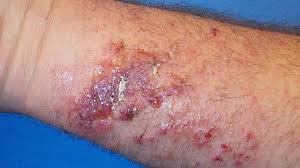
An inflammation of the skin caused by contact with certain plants during recreational or occupational exposure to sunlight.
The inflammatory response is a phototoxic reaction to photosensitizing chemicals in several plant families.
Phytophotodermatitis is a photo toxic non-immunologic skin reaction that results from exposure to furocoumarins, a plant substance found in limes, lemons, celery, and parsley and ultraviolet light.
Caused by a chemical reaction which makes skin hypersensitive to ultraviolet light.
Phytophotodermatitis occurs when UV radiation induces inflammation of the skin after contact with certain plants: limes, celery, and meadow grass.
It causes pain, redness, and blistering of the skin in the distribution of plant exposure.
Commonly is due to exposure to limes, and is also known as lime disease.
Other plants include lemons, celery and parsley.
The above agents may cause a reaction following contact with different parts of the plant including the fruit, juice, stems and leaves.
It is frequently confused with hereditary conditions such as atopic dermatitis or chemical burns, but it is caused by contact with the photosensitizing compounds found naturally in some plants and vegetables like parsnips, citrus fruits, and more.
The most common plant family to cause PPD is the Umbelliferae family.
Most commonly caused by ingestion of or topical exposure to psoralens.
Psoralens have been isolated from at least 4 different plant families: Umbelliferae, Rutaceae, Moraceae, and Leguminosae.
The most common compounds are furocoumarins that are capable of provoking phototoxic reactions are limes, lemons, oranges and tangerines.
Characterized by bizarre configuration of erythema with sharply demarcated border confined to the area in contact with the offending plants and consequent sun exposure.
The primary skin lesions range from delayed erythema to frank blisters.
The skin lesions are limited to the areas in contact with furocoumarin and with sunlight exposure.
Vesicles and bullae may develop 24 hours after and peak at 72 hours after exposure, often associated with subsequent desquamation and denudation.
Pruritus is not common.
Skin color varies depending on the patient’s underlying skin tone and the degree of the reaction.
Diagnosis is based on history and pattern of disease.
Treatment includes topical glucocorticoids.
Wet dressings may be indicated in the acute vesicular stage.
Resulting from contact with light-sensitizing botanical substances, particularly from the plant families Umbelliferae, Rutaceae, Moraceae, and Leguminosae.
Results from ultraviolet light, typically from sun exposure.
Usually results in hyperpigmentation of the skin.
Clinical findings may be accompanied by blisters or burning.
The reaction usual begins within 24 hours of exposure and peaks at 48–72 hours after the exposure.
Affects people of any age.
Often mistaken in children for child abuse because bruise-like appearance that is usually in the shape of handprints or fingerprints.
Umbelliferae plants include: Wild parsnip, parsley, celery, common hogweed, carrot
Rutaceae include: Lemon, Lime.
Prevented by staying indoors after handling the above substances.
.
